The 15 Directors We’d Most Like to Put Their Own Spin on a Superhero Movie
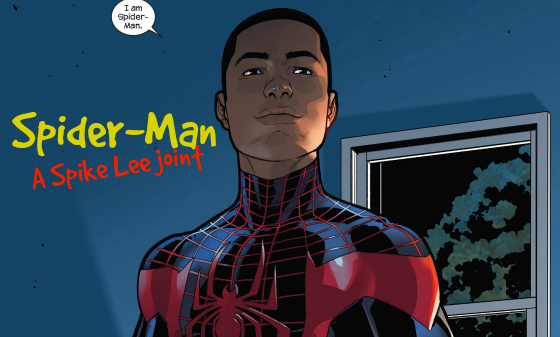 |
It could perhaps be argued that the best – or at least the most interesting – superhero movies made to date were the ones that came from idiosyncratic directors. Captain America: The Winter Solider was all well and good, I suppose, but it’s the type of film that feels more like a studio mandate (which it was) than an urgent tale told my a creative mind eager to explore something new. The notion of the “auteur superhero movie” is not largely explored in today’s marketplace, which values mythbuilding and multiple-film story arcs over singular, thoughtful deconstructive explorations of a superhero character (although, since Topless Robot recently endorsed Ava DuVernay to direct a Marvel film, we may see the age soon. Fans may even want it.).
Occasionally, you’ll have an auteur at the reigns: Tim Burton, Christopher Nolan and Ang Lee have all taken a crack at a superhero. The result from the auteur camp is either something to be embraced as a new paradigm, or (in the case of Lee) rejected for its intellectual archness (Just for the record, I’m one of the world’s only fans of Ang Lee’s Hulk). This gets my mind whirling, of course. What if other famous “auteur” directors were granted their own chance to make a high-profile superhero movie? As a fun intellectual exercise, I have assembled fifteen notable auteur directors currently working (who haven’t already made superhero movies), and assigned them their ideal superhero and comic book properties.
1. Director: Quentin Tarantino
Superhero: Luke Cage
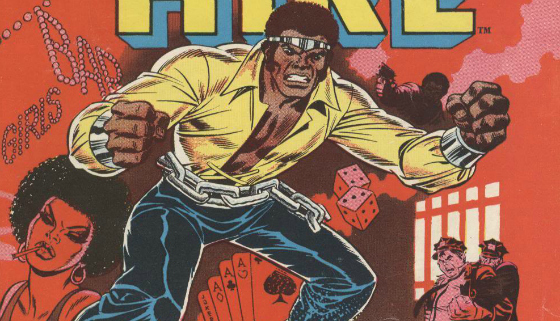 |
Tarantino’s openly announced penchant for ’70s blaxploitation and trashy drive-in kung-fu fare would make him an ideal candidate for Luke Cage, Hero for Hire.
Luke Cage was a Marvel superhero introduced in 1972 as part of the golden age of blaxploitation. He was a street-level superhero who would help out anyone who could afford him, although possessed of a social conscience, leading him to clean up the poor neighborhoods of New York. Luke Cage has been most closely tied to the Avengers, and Marvel/Disney currently has plans to make a Luke Cage miniseries, as part of their multi-character Defenders event, intended for release on Netflix over the next few years. Luke Cage is a less flashy superhero, more geared toward the real-life grit of street crime than the superpowered alien shenanigans of the Avengers.
Quentin Tarantino has had, as I’m sure most of you have noticed, a recent penchant for social vengeance films; both Inglourious Basterds and Django Unchained have been elaborately realized revenge fantasies structured around Europe’s and America’s historical injustices. Tarantino has been re-writing history in favor of the wronged underdog. Black people murder the racist whites in the slavery-era South, and America finally kills Hitler when it would have made the most difference. I sense that Tarantino, then, would transform Luke Cage into an angel of vengeance in the 1970s, a figure to fight violently against poverty and racism in the modern world. This would be no safe-for-teens PG-13 superhero film either. Luke Cage would go way, way off the rails really early on, openly murdering bad guys, and eventually taking down The Man in a hail of bullets. Think of something like Shaft, but longer, wittier, more violent and way more audacious.
Also, look out for constant use of the word motherf****er.
2. Director: Baz Luhrmann
Superhero: Dazzler
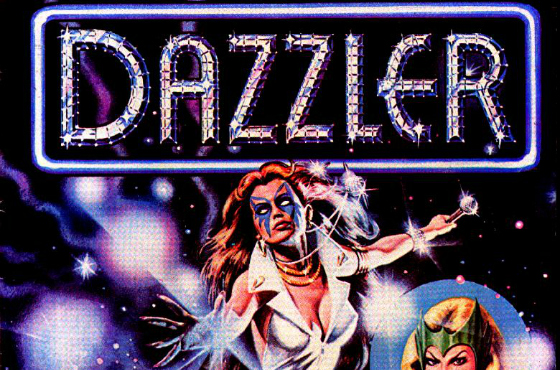 |
Australia’s Baz Luhrmann has one cinematic aesthetic thoroughly nailed: the man knows glitz. With movies like Moulin Rouge! and The Great Gatsby, Luhrmann has proven that he knows his way in and out of opulence. Bright lights, glamor, and excess are the words of the day. Even going back to something like the very-good-but-very-dated Strictly Ballroom, Luhrmann has proven that he’s just as concerned with sequins as he is with story and character… perhaps even more so. Luhrmann’s emotions run toward the operatic, his visual milieu toward the disco ball.
As such, Luhrmann would be ideally suited for a superhero character who is noted for their shining, glittering excess. So I nominate Dazzler, a semi-obscure X-Men character first introduced in 1980.
Dazzler was a young woman who had the ability to turn sound into light. She could sing, and rainbow disco beams would appear magically in the air around her. In her original incarnation, she wore a fantastically dated 1980s bodysuit and, get this, mirrored rollerskates. She would moonlight as a popular nightclub crooner, who would sing the hot hits of the day, and use her superpowers to, well, dazzle the audience. In crimefighter mode, well, not much would change – rollerskates and disco rainbows would be used to take down bad guys. I would love to see Luhrmann dive into the coke-addled excess of America’s early-’80s disco scene, coating everything in mirrors, allowing Dazzler to become a minor deity during the Last Days of Disco. Luhrmann already treats glitter and glitz as if its a superpower anyway, so why not make his busy visual milieu into something more literally powerful?
Dazzler. She created disco.
3. Director: Martin Scorsese
Supervillain: The Joker
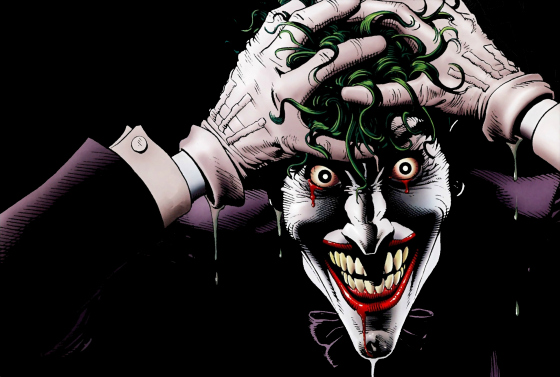 |
This right away: Martin Scorsese’s The Wolf of Wall Street was indeed one of the best films of 2013, and the director’s finest work since… well, since his last film. Scorsese is amazingly consistent, isn’t he? His duds are few and far between, and even something like, oh, Gangs of New York is impressive and ambitious. I shouldn’t have to remind you of the varied and awesome crime films that Scorsese is capable of making. Indeed, he has delved so wonderfully and effectively and energetically into the world of urban crime, it’s almost a wonder that he hasn’t thought to make a movie about a vigilante yet. Oh wait. Does Taxi Driver count? Travis Bickle as a superhero? I’m guessing that’s what a superhero would look like to Scorsese. No fantasy. No superpowers. Just a crazy guy with a gun.
As such, I think we need to steer Scorsese away from outright superheroes, and more toward the more interesting facet of the superhero universe: the arch enemies. Forget the altruistic guys in tights who punch muggers; a more fascinating tale would be the origin of a crime boss with a costume and a gimmick. I hereby pair Scorsese up with the world’s most well-known comic book supervillain, the Joker.
Few on-screen renditions of the Joker have bothered to explain his origin. What drives someone to dress like a clown and spread chaos through the big city? Christopher Nolan turned the Joker into a youthful anarchist. I suspect Scorsese, a comparatively more sensitive and earthy director, would transform the violent Joker into a more relatable figure. In The Wolf of Wall Street, Scorsese looked at the horrific life of Jordan Belfort and gave him a there-but-for-the-grace-of-God quality. I suspect he would give a similar approach to the Joker. He’s not an ineffably evil serial killer, but a regular man who just gave into his wilder impulses. And without a Batman to fight against, we could really get to know the character for the first time.
And we all want to know the Joker better, right?
4. Director: Michael Bay
Superhero team: Youngblood
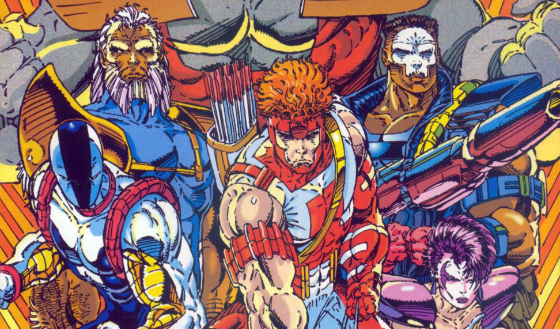 |
Although Michael Bay’s film are typically staggeringly popular (how much money did Transformers: Age of Extinction make? Really? A billion dollars?) I know few – if any – people who describe him as a great director. An auteur, no doubt – Bay most certainly has a distinct and instantly recognizable aesthetic – but not a great director. He is a master of wrangling gigantic action set pieces to be sure, but his films are marked by a a form of visual and aural cacophony that usually has critics running for the doors. Well, we would run for the doors, if our sense of professional obligation didn’t keep us seated.
Bay’s military-festishizing, helicopters-at-sunset style could easily be applied to Youngblood. And just who the heck are Youngblood? In the early 1990s, there was some legal rigmarole in the comics world, wherein artists and writers would debate as to who should get credit for inventing a character; the illustrators were rarely if ever credited in such matters. In 1992, one Todd McFarlane recruited several famous illustrators and founded Image Comics, a company that allowed artists to invent their own characters. For the most part, the characters invented were great looking, but rather dumb. Most of the new Image Comic superhero teams were bland, violent paramilitary types in impractical outfits. The biggest title at the time was Rob Liefeld’s Youngblood, although that title is largely interchangeable with Wild C.A.T.s, Wetworks, Brigade and Cyber Force.
Bland, violent paramilitary types? Why that’s Bay, head to toe! The clunky, dumb, forgettable characters of a team like Youngblood would fit right into Bay’s pushy aesthetic. Bay needs to stay away from Ninja Turtles, and focus on characters with dubiously cool nicknames like Coldsnap.
Oh crap, and Shadowhawk. Remember Shadowhawk? What the heck was wrong with us?
5. Director: Spike Lee
Superhero: Spider-Man
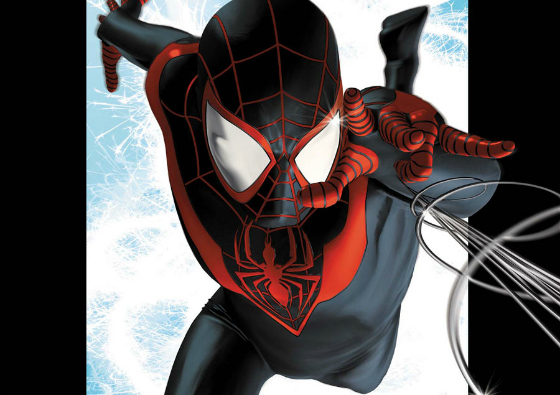 |
Perhaps in a bid to add some cultural and racial diversity to their lineup of largely Caucasian superheroes, Marvel recently (in 2011) introduced a parallel universe version of Spider-Man who was a half-black, half Latino kid named Miles Morales. This “Ultimate Universe” Spider-Man was instantly accused by critics of being a cheap way of pandering to political correctness, although I would argue that any attempts to make comic books more culturally diverse are good things. Indeed, why not play up Spider-Man’s race? Why not make him into a blacktino kid? Why not have him interact with a diverse New York, allowing him to live in a more specific community?
And who know who is an expert at exploring specific racial communities in New York? Why, Spike Lee, of course. Ever since the now-classic Do the Right Thing was released back in 1989, Lee has been seen as a blusterous rabble-rouser who brings up issues of race to a white society that likes to think it’s living in a post-racial world, but really isn’t. His films are ballsy, blunt, preachy, and some of them are amazing.
Lee, like Scorsese, would likely eschew the more fantastical elements of a superhero comic, and focus more on the character of the person who would choose to be a superhero. What kind of young kid, growing up in Bed-Stuy, would want to be a superhero? It would be less about the kid-friendly version of Saturday morning nobility that we usually get from superhero movies, and more a hard-edged, teary, balled fist of racial injustice. This Spider-Man would want to go after white cops, perhaps, and would have to learn that not everything is about race… except when it is.
Spider-Man. A Spike Lee joint. Feels good.
6. Director: David Lynch
Superhero: Sleepwalker
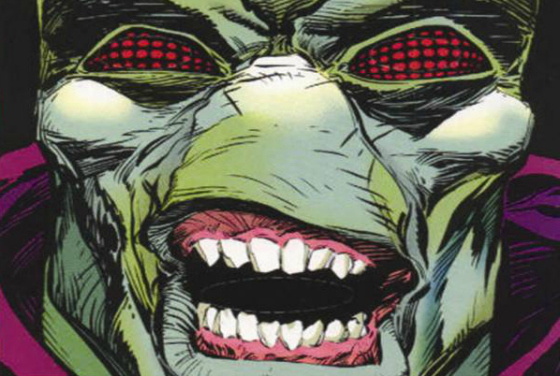 |
Many essayists and critics have described David Lynch’s style as “dreamlike.” His outwardly surreal films tend to be slowed, dusty, and dark. A David Lynch film takes place in a jazz club in a dream, a club where the main room has indistinct but hugely moving music, but in the back room, someone is clearly being beaten savagely by greasy men in suits. And then you turn into someone else. Like many critics, I find Lynch’s films to be bracing, awesome, and terrifying. It’s been said that cinema is the art form to most closely resemble dreams, and few directors can capture the feeling of dreams the way David Lynch can. Bu?uel, maybe.
David Lynch could not – indeed, should not – direct big action blockbusters; the usual Spider-Men and Supermen would simply not fit together with the creative mind exploration that he is more comfortable with. There is, however, a less-known Marvel character lurking out there called Sleepwalker. Sleepwalker, invented in 1991, was an interdimensional alien who lived within human dream space. When you dream, you see, you’re actually psychically visiting another dimension. Sleepwalker was a creature who managed to escape into the waking world when his “host” dreamer fell asleep. He could then essentially manipulate the “real” world to more closely resemble dreams.
In the comics, Sleepwalker was, of course, a superhero and a crime-fighter. In David Lynch’s version, however, Sleepwalker would be the director’s ultimate conduit for his violent dreamlike fantasies. Lynch likes to sidle gently between dreams and reality anyway, so why not hand him a character who can do that very thing? It would be weird, challenging, and terrifying. It would be a film I would most certainly want to see.
Also, if you fall asleep during the movie, you wouldn’t be able to tell!
7. Director: Frank Henenlotter
Superhero: Sludge
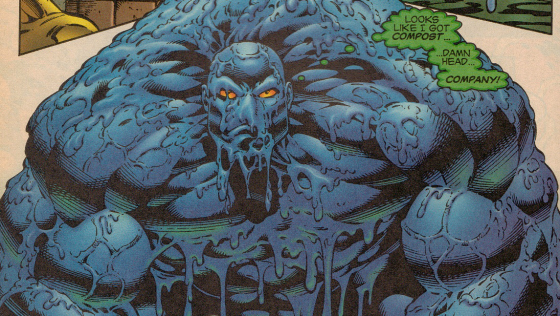 |
There are two types of people in this world: Those who love Frank Henenlotter, and those who haven’t discovered him yet. Frank Henenlotter is, for the many of you who may not be familiar, the master auteur behind such slimy genre classics as Frankenhooker, Basket Case, and Bad Biology. He works with horror of the body, but with a trashy, almost cartoonishly sexual edge. No one can do rubbery cartoon chaos better than Frank Henenlotter, and his use of practical creature effects will never be matched. Watch Basket Case 2 someday, and witness the perfection.
For Henenlotter, I had to delve into the deeper trenches of comics history to find a character who would be gross enough. Ladies and gentlemen, may I introduce you to Sludge, a totally obscure character invented by Malibu Comics in 1993. Sludge was once a policeman who was murdered and thrown into a sewer. The sewer was then doused with magical chemicals, essentially fusing the dead policeman with the filth and grime around him. So yes, Sludge was essentially a superhero made of human waste. How this became an actual title, I’ll never understand. I guess in the 1990s, we were far more lenient with what we allowed into comic book store shelves.
I have a feeling that the New Work-based Henenlotter would turn something like Sludge into a real hoot. Henenlotter has just the right sense of humor to turn an obscure comic about a walking filth pile into something watchable and entertaining. What’s more, he would likely (I would hope) cleave to practical special effects, making the hero/monster into something awesome to behold. Sludge would, I imagine, fall somewhere in between The Toxic Avenger and Alex Winter’s Freaked. If that’s the case, they’ve already sold one ticket.
The world could use some more sewage-based superheroes as a whole.
8. Director: Woody Allen
Superhero: Superman
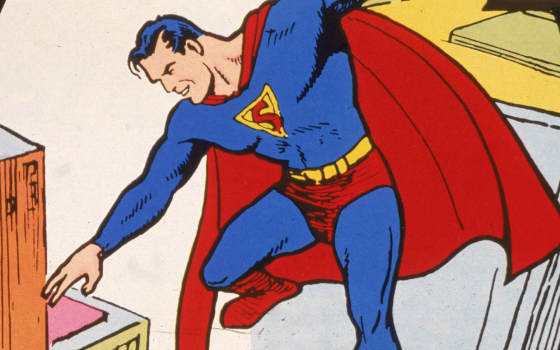 |
Sometimes a mismatch is required. Woody Allen, that urbane master of romantic neuroses and prolific hit-and-miss auteur of recent years, is the last person who should tackle earnest power fantasies. Allen’s fantasies run more toward the sexual. Although many of his films feature magical elements, they don’t possess the fantasy structure of most comic books, which have to play by specific rules to work as dramatic constructs. If Woody Allen were to invent a superhero, he wouldn’t ever fight crime, too preoccupied would he be with his girlfriend’s infidelity and his own desire to get with a new girlfriend to really bother.
But when you think about it, that clash between the fantastical and the mundane is really the spirit of most superhero comics. Spider-Man for instance, is most interesting when he’s juggling his job as a superhero with the fact that he needs to keep a job, and prevent his Spider-Man costume from running in the washing machine.
As such, I would love to see Woody Allen’s neurotic take on Superman. Imagine a more nebbish Superman. A Supermensch, if you will. A Superman who wears the outfit, but who spends time going to Godard films, and endlessly discusses his relationships with human best friends who barely tolerate his whining. In Zack Snyder’s Man of Steel, we saw a steely, cold, non-heroic version of Superman who couldn’t stop the destruction of a large city. In Woody Allen’s Superman, we would see no fighting, no destruction, and no wrestling with any sort of large, bold, dumb mythology. We’d only see a powerful man, brought to his knees by his own insecurities. And it would be hilarious.
“As Superman, I wanted to say you know nothing of my work.”
9. Director: Wes Anderson
Superhero: Booster Gold
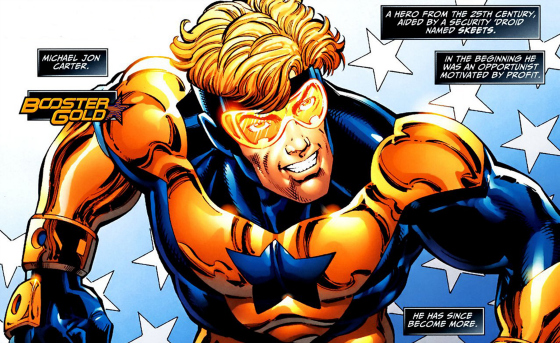 |
Wes Anderson’s lead characters all have one quality in common: Their dutiful sense of self-theatricality. The leads in Wes Anderson films have all unilaterally adopted carefully selected and highly-mannered personae for themselves, often declaring to the world how different they are. They are all essentially showboats who have chosen clothing and music like hipster uniforms, determined to live their lives the way they want to live them. More often than not, Anderson’s characters are trapped within their own uniforms, unable to relate to a world that doesn’t understand them.
Although the DC comic character Booster Gold, invented in 1986, is less about hipster affect and more about glitter and fame, I feel he would be a good match for Anderson’s metier. Booster Gold is, for those who don’t know, a time-traveling superhero from the future who uses future technology to save people. He is driven by his own vanity more than he is by his altruism. He also has – and I apologize to the character’s fans (both of them) – one of the goofiest superhero names I have ever heard. “Booster Gold” sounds like a drink additive or a weight-gain protein powder to me. That he tools around with a robot named Skeets doesn’t help matters.
A hero driven by vanity is no new thing; giving a superhero a giant ego is one of the most common ways to spoof the entire notion of superhero-dom. But if one were to parlay that super-ego into the calm, impeccably artistic, hipster surroundings of a Wes Anderson movie, then we’d be able to see how certain superheroes really are trapped by their own egos. Would you be a superhero if you didn’t get to wear a costume? Probably not. There is an affect to all superheroes. Wes Anderson’s Booster Gold would reveal that disconnect.
Booster Gold. Snicker snicker.
10. Director: John Waters
Superhero: Rawhide Kid
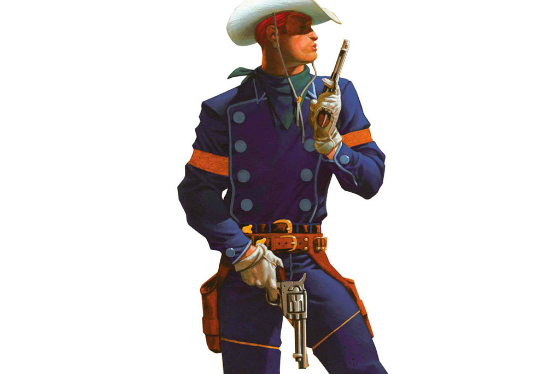 |
No one has heard of the Rawhide Kid. He first appeared in comics way back in 1955, and has been quietly keeping to himself in the ensuing decades. He was a heroic gunfighter of the old west – a pretty standard stock character that was already ancient in 1955. The character was brought back occasionally throughout the 1960s, but never achieved any sort of real fame. Then in 2000, The Rawhide Kid was resurrected by Marvel Comics as a gay character. The Rawhide Kid may not have been the first gay cowboy in pulp history, but he was one of the highest profile to date. The comics were also loaded with comic gay innuendo; the Rawhide Kid was not going to be shy about his sexuality. This was no mere attempt to make an incidentally gay character. This was an attempt at high camp.
And who better to handle high camp than the master himself, John Waters? Waters has never made a western before, but I suspect he was raised on movies like Johnny Guitar, and has likely understood the temptation to make a western more gay. They’re pretty gay already, right? Pairs of lone men out on the prairie, away from the womenfolk? We’ve all thought about it. Heck, Ang Lee made an amazing dramatic romance about it in 2005. So let John Waters take a campy gay cowboy and make a campy gay cowboy movie.
O.k., so maybe the Rawhide Kid isn’t technically a superhero, but he is a character from a Marvel comic, and I think that ought to count for something. Plus, a Rawhide Kid movie would give John Waters a chance to direct again, a privilege neither he nor the world has enjoyed since 2004’s underrated filth-fest A Dirty Shame.
But please, no pudding.
11. Director: David Cronenberg
Superhero: Husk
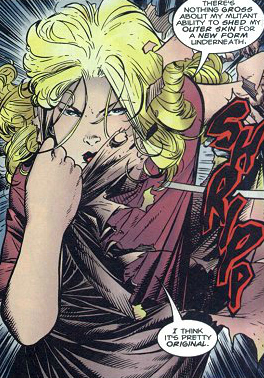 |
I know that in his most recent decade of work, Canadian director David Cronenberg, perhaps Canada’s most important cinematic auteur, has been skewing calmer and calmer, and less gory and fleshy. His last film, the rather great Cosmopolis, was an indictment of extreme American wealth in the post-recession era. His early films, however, is what he’s still known best for, and it’s not for nothing that critics often cite him as a master of body horror.
Cronenberg’s films tend to be about the body. Appetites and lust, yes, but also about our very skin, our very blood, our very orifices and apertures. Just watch his 1986 classic The Fly and watch how he delves into bodily horror with some of the most disgusting panache ever committed to film.
There is another obscure X-Men supporting character out there in the giant basin of comic book personalities called Husk. Husk is a teenage girl who can essentially pull off her own skin to reveal new skin underneath. The new skin can be made of anything she desires, but she does leave a fleshy carapace on the ground behind her whenever she transforms. I would love to see Cronenberg make a twisted, slow, thoughtful feature film about a young girl, perhaps going through puberty, who sloughs off her skin on a regular basis, changing, ever changing, through her own sexuality. Heroic? Perhaps not. But an interesting film nonetheless.
Just try not to think of the skin goop.
12. Director: Lars von Trier
Superhero: The Punisher
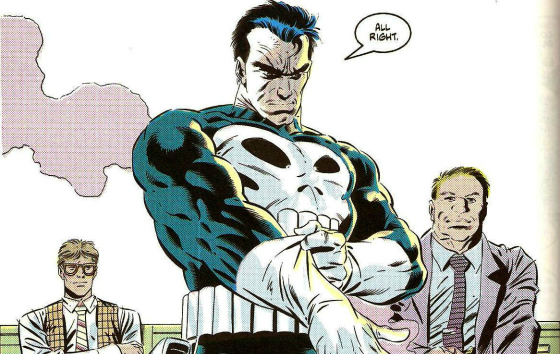 |
This one was kind of a no-brianer. On the surface, it may not seem that the ultra-violent, Death Wish-inspired gun nut the Punisher has anything to do with the terrifying depression of Lars von Trier, but in my mind, they synch up perfectly. Lars von Trier has spent most of his films (especially films like Antichrist and Melancholia) deeply and enthusiastically exploring the mindset of human despair. Despair, he seems to argue, is our default mode, and it can cause us to commit extreme acts of violent cruelty. Forgiveness, hope, joy, love… these things are all but pathetic masks we have built to cover up our real beings. And our real beings are black, oily monsters made of rage and despair.
Doesn’t this sound like the ethos of the Punisher to you? Although the Punisher (invented in 1974) was clearly a derivation of the hard-edged, revenge thrillers of the 1970s, he always struck me as the inevitable conclusion of all costumed vigilantes. Why dress like a spider and punch muggers, when you can dress in black, wear a skull on your chest, and murder any and all people you feel are deserving? The Punisher is the logical extreme.
And why not push that extremity into the place of rage and despair where Lars von Trier lives? The Punisher is full of rage and despair. He kills people out of altruistic cruelty.
Put a gun in Stellan Skarg?rd’s hand and let’s get this party started.
13. Director: Jim Jarmusch
Superhero: Constantine
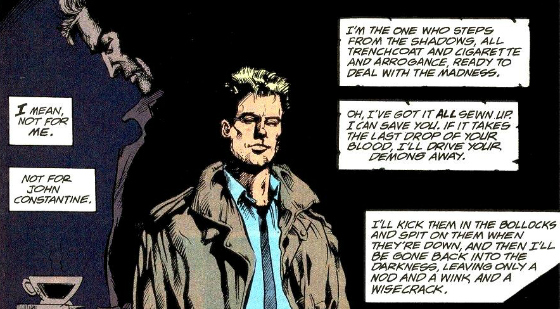 |
I mentioned “hipster affect” when talking about Wes Anderson, but even more affected and even hipper is indie boom darling Jim Jarmusch. Jarmusch makes movies about odd people, lost in their own personally constructed mazes of cool, constantly butting heads with the outside world. His dialogue is intentionally stiff, and feels improvised. Unlike Anderson, however, Jarmusch’s coolness is less about clean lines and good manners, and more about tobacco, coffee, loud music, and ancient musical instruments. There is an element of chaos in Jarmusch’s coolness.
Trying to come up with a superhero for Jarmusch was difficult, but I ultimately settled on John Constantine, the Vertigo comics character from the 1988 comic Hellblazer. Constantine – who was already featured in a 2005 film and a current TV show that may or may not get renewed – is a con man and freelance paranormal investigator, constantly tortured by ghosts and the supernatural. He lives in a dark world of dank bars, wet alleyways, dumpy apartments, and really really cool clothing.
I imagine Jarmusch turning Constantine into something like a dejected Goth kid, grumpy all the time, but always carefully aware of how he looks and how he is presenting himself to the world. There would be no story in this film. Constantine would just have long conversations about how awful everything is.
Tom Waits could play the ghost of Constantine’s father. The soundtrack to this film would be amazing.
14. Director: Gus Van Sant
Superhero: Robin
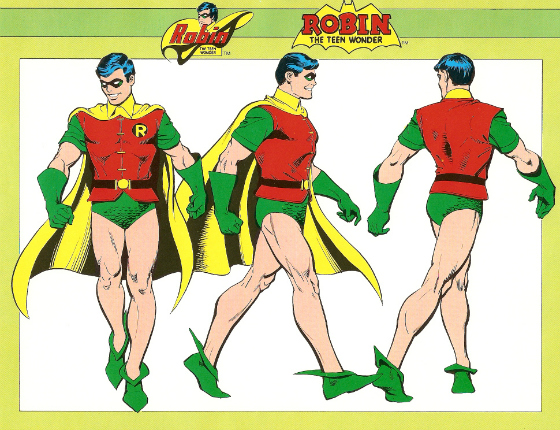 |
Gus Van Sant seems to have two personalities. On the one hand, we have the bold, bright, mainstream filmmaker who can make clean and nonthreatening Hollywood blockbuster biopics like Milk, and weepy indie-like dramas like Finding Forrester and Good Will Hunting. On the other hand, Gus Van Sant made challenging bizarro meditations on difficult subjects. Films like Last Days, Gerry, and Elephant.
So why pick Robin for Gus Van Sant? Well, Van Sant has definitely had a penchant for youth in many of his films. He appreciates the complexities and the intensity of the teenage mind, especially in his quieter experiments. He likes to explore the fashion and the heart of the teenager, emphasizing that the emotions are huge and epic and raw during those few years of your life, but you have no way to express yourself other than seemingly random acts.
So it seems to me that the Boy Wonder would be a perfect fit for Van Sant. True, it would be a quiet film about teen angst rather than an action film about proving yourself to Batman, but teen angst must still effect superheroes, right? Here’s a teenage boy who has to prove himself to the world, prove that he is a good human being, but he can only do it through his costume and through his violence. He could make a peaceful film about a superhero, and that’s not something we’ve seen too much of.
And Gus Van Sant would make Robin look amazing, what with the J. Crew outfits.
15. Director: The Coen Bros.
Superhero: Ambush Bug
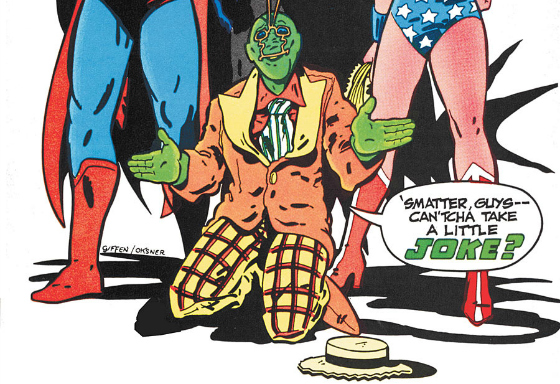 |
How to describe Ambush Bug to the uninitiated. Ambush Bug was a spoof superhero counterpart to the more serious DC characters around him. Invented in 1982, Ambush Bug was a perfect superhero parody who ran alongside a golden era of superhero parodies; this was the era of the Flaming Carrot, Megaton Man, Forbush Man, the Tick, and Captain Klutz. Forget the somber philosophical nonsense of the modern superhero era. To me, the true heart and soul of – and deep affection for – superheroes comes from this age of goofy, playful satires. If you can’t make fun of something, then you don’t deserve to truly love it.
Ambush Bug’s origin is decidedly bizarre: A mentally unbalanced man named Irwin found the abandoned clothes of a long-lost alien space lord. The clothes themselves were mixed with a giant space spider. Or something. It’s hard to tell. Irwin put on the clothes and became a superhero of dubious effectiveness.
The Coen Bros. are perhaps known more for their playful fatalistic agony than they are for their slapstick, but I see them handling a character like Ambush Bug with ease and aplomb. The characters in Coen Bros. movies are usually shiftless and clueless and often pathetic figures who are pushed around by fate. Superheroes typically create their own fate. But if someone is putting on a superhero outfit, they’re probably, realistically, a little mentally ill. And The Coen Bros. would be perfectly expert in creating a clueless superhero character who is pushed around by fate, and who refuses to accept – or is incapable of accepting – their own fate.
Or maybe it would just be weird. That works for me!
Previously by Witney Seibold:
The Seven Best Episodes of Tales from the Crypt
TR’s 10 Worst Nerd Films of 2014

